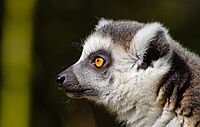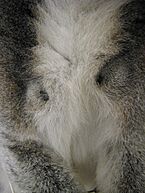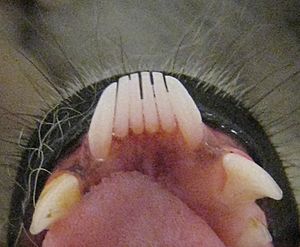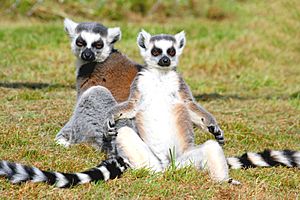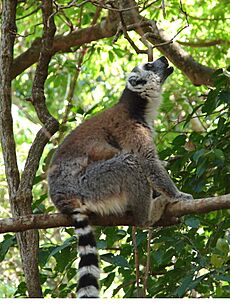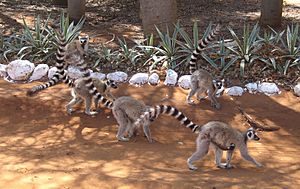Ring-tailed lemur facts for kids
Quick facts for kids Ring-tailed lemur |
|
|---|---|
 |
|
| Conservation status | |
| Scientific classification | |
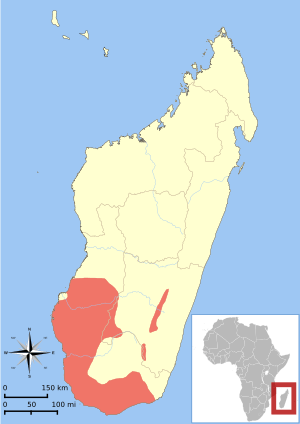 |
|
| native range |
The ring-tailed lemur (Lemur catta) is a medium-sized primate famous for its long, bushy tail with black and white rings. It is the most well-known of all the lemur species. Like all lemurs, it is native to the island of Madagascar.
Locally, it is known in the Malagasy language as maky or hira. Ring-tailed lemurs live in the forests and scrublands in the southern part of the island. They are omnivores, meaning they eat both plants and animals. They are also the most comfortable of all lemurs with living on the ground.
Ring-tailed lemurs are very social and live in groups called "troops," which can have up to 30 members. These groups are led by females. To stay warm and strengthen their bonds, the lemurs will huddle together. They also groom each other to stay clean and show friendship.
This lemur is active during the day. A common sight is a ring-tailed lemur sunbathing in the morning. It sits upright and faces the sun to warm its belly. Because of habitat loss and other threats, the ring-tailed lemur is an endangered species.
Contents
What's in a Name?
The word "lemur" comes from the Latin word lemures, which means "ghosts" or "spirits." Early scientists may have chosen this name because of the lemurs' large, reflective eyes, their loud calls, and their quiet movements.
The second part of its scientific name, catta, is Latin for "cat." This is because the ring-tailed lemur makes a purring sound much like a house cat. Its cat-like appearance also contributed to the name.
Where Lemurs Come From
All lemurs are found only on the island of Madagascar. Scientists believe that millions of years ago, a small group of ancient primates arrived on the island, possibly by floating on a large piece of wood or vegetation.
Over time, these early primates evolved into the many different types of lemurs that live on Madagascar today. This process is called evolutionary radiation. Genetic studies show that the ring-tailed lemur is most closely related to bamboo lemurs.
Appearance and Physical Features
The ring-tailed lemur has a slender body and a narrow, fox-like face. On average, it weighs about 2.2 kilograms (4.9 lb). Its body is about 39 and 46 cm (15 and 18 in) long, but its tail is even longer, measuring up to 63 cm (25 in).
Its most famous feature is its tail, which has 12 or 13 white rings and 13 or 14 black rings, always ending with a black tip. The tail is not used for gripping branches but helps the lemur balance as it moves. It is also used to communicate with other lemurs.
Its fur is thick and soft. Its back is usually gray or rosy-brown, while its chest and belly are white. Its face has white fur on the cheeks and dark, triangular patches around the eyes. Like many animals that are active at night or in dim light, it has a special reflective layer behind its eyes called a tapetum lucidum, which helps it see better.
Both male and female ring-tailed lemurs have scent glands on their wrists and chest. Males have an extra feature: a thorny spur on their wrist gland. They use these glands to leave scent marks, which is an important way they communicate.
Their hands and feet are well-suited for life both in the trees and on the ground. They have thin fingers with flat, human-like nails. On their second toe, they have a special claw-like nail called a toilet-claw. They use this claw for grooming their fur.
A Special Toothcomb
Ring-tailed lemurs have a unique dental feature called a toothcomb. It is formed by their bottom front teeth, which are long, thin, and packed closely together.
They use this toothcomb to groom their own fur and the fur of other lemurs in their troop. This helps keep them clean and strengthens social bonds within the group.
Habitat and Predators
Ring-tailed lemurs live in the southern and southwestern parts of Madagascar. They can be found in a variety of habitats, from deciduous forests and dry scrublands to forests along riverbanks, which are their favorite.
This species is the most terrestrial of all lemurs, meaning it spends a lot of time on the ground (about 33% of its time). However, it is still skilled at climbing and spends much of its day in the trees.
The ring-tailed lemur has several natural predators, including:
- The fossa (a cat-like mammal)
- The Madagascar harrier-hawk
- The Madagascar buzzard
- The Madagascar ground boa
What Do Ring-Tailed Lemurs Eat?
The ring-tailed lemur is an omnivore, but it mostly eats fruits and leaves. Its favorite food is the fruit from the tamarind tree. When available, tamarind can make up half of its diet.
Besides fruit, its diet also includes:
- Flowers
- Herbs
- Bark and sap
- Insects like caterpillars, cicadas, and spiders
- Small animals like birds and chameleons
During the dry season, when food is harder to find, the lemur becomes less picky and will eat almost anything it can find.
A Very Social Animal
Ring-tailed lemurs are highly social and live in groups called troops. These troops are like big families, and they do almost everything together, from finding food to sleeping.
Life in a Troop
A troop usually has between 6 and 30 members, with an average of 13 to 15. Unlike many other primate groups, lemur troops are led by females. The dominant female is in charge and gets to eat first. She is also responsible for defending the troop's territory from rivals.
Young males leave the troop they were born in when they are between three and five years old to find a new group.
Sun Worshippers
In the morning, ring-tailed lemurs often sunbathe to warm up after a cold night. They sit upright, with their legs stretched out, and face the sun. This posture, often called a "sun-worshipping" pose, exposes their thin belly fur to the sun's rays, helping them warm up quickly. Sunbathing is often done as a group activity.
At night, the troop splits into smaller groups and huddles together to stay warm while they sleep.
Communicating with Scents
Scent is a very important form of communication for ring-tailed lemurs. They use their scent glands to mark their territory. They rub their glands on trees and bushes, leaving behind a unique smell that tells other lemurs that this area is occupied.
Males use their wrist glands and spurs to scratch tree trunks, leaving both a visual and a scented mark. This is called spur-marking.
Stink Fights!
When male lemurs compete with each other, they engage in a unique behavior called a stink fight. A male will rub his long tail over the scent glands on his wrists and chest, covering it in his smelly secretions.
He then waves his scented tail at his rival. The lemur with the stronger or more intimidating smell often wins the conflict without any physical fighting.
Lemur Language
The ring-tailed lemur is one of the most vocal primates. It uses a wide range of sounds to communicate with its troop. These calls can be used to keep the group together while they search for food or to warn others of a nearby predator.
Some of their sounds include:
- Moans and wails: Used to keep in contact with the group.
- Clicks: Used to get the attention of other lemurs.
- Purrs: A sound of contentment, much like a cat.
- Yaps and shrieks: Used as alarm calls when a predator is spotted.
Life Cycle
The mating season for ring-tailed lemurs is from mid-April to mid-May. After a gestation period of about 135 days, females give birth in September or October.
Usually, a female has only one baby, but twins are possible. A newborn lemur weighs only 70 g (2.5 oz). For the first two weeks, the baby clings to its mother's chest. After that, it rides on her back.
Young lemurs start eating solid food at two months old and are fully weaned by five months. The whole troop, including other females and males, helps care for the young. In the wild, ring-tailed lemurs can live for about 16 to 20 years. In zoos, they have been known to live up to 27 years.
How Smart Are They?
For a long time, lemurs were not considered to be as intelligent as monkeys and apes. However, recent studies have shown that ring-tailed lemurs are quite smart.
They are capable of learning complex tasks and can even be taught to organize items in a sequence from memory. Some research suggests they can understand simple math.
Although they don't use tools in the wild, experiments have shown that ring-tailed lemurs can learn to use tools to get food. They can also figure out which tool is best for a certain job, showing that they understand how tools work.
An Endangered Species
The ring-tailed lemur is listed as an endangered species by the IUCN Red List. In 2017, it was estimated that the wild population had dropped to as low as 2,000 individuals.
The main threats to the ring-tailed lemur are:
- Habitat destruction: Forests in Madagascar are being cut down to create farmland and pasture for cattle. This is the biggest threat to their survival. It is estimated that 90% of Madagascar's original forests are gone.
- Hunting: Lemurs are sometimes hunted for food (bushmeat) or captured for the illegal pet trade.
- Drought: The southern part of Madagascar often experiences long periods of drought, which can make it hard for lemurs to find enough food and water.
Many organizations are working to protect the ring-tailed lemur. They live in several national parks and reserves in Madagascar, where they are protected. They also breed very well in zoos around the world. There are over 2,500 ring-tailed lemurs in captivity, which helps ensure the species does not go extinct.
Interesting facts about the Ring-tailed Lemur
- Lemurs are considered older, in an evolutionary sense, than monkeys and apes.
- They are found nowhere else on Earth in the wild except the island of Madagascar.
- The tip of their tail is always black.
- They have a special "grooming claw" on the second toe of each back foot. This claw helps it comb through fur that its mouth cannot reach.
- Females are always in charge, they get first choice of food, and they defend the group's territory.
- One of their most bizarre and unique behaviors is known as "Stink Fighting". Males coat their tails with smelly secretions from scent glands on their wrists and wave their stinky tails at each other in a battle for dominance, and the smelliest male often wins!
- Troops of the Ring-tailed Lemur hold their tails high in the air like flags when traveling to keep the group together.
Images for kids
See also
 In Spanish: Lémur de cola anillada para niños
In Spanish: Lémur de cola anillada para niños




